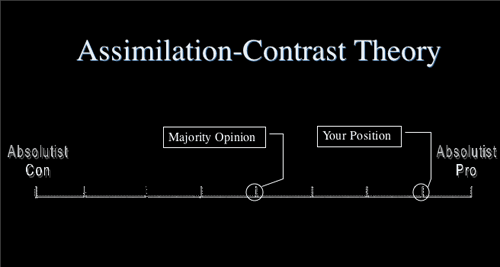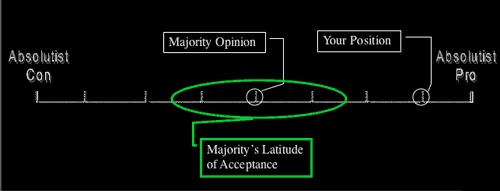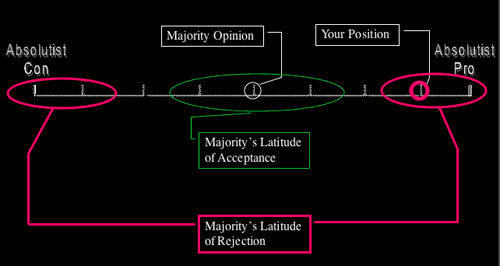Communication Strategies
NM2219
Dr. Linda M. Perry
- Strategies
- Information in messages must meet criteria for the target
public. It should
- Appeal to some value.
- Be believable.
- Not conflict with other beliefs or values.
- Come from a trustworthy source.
- Based on understanding of what motivates the target public.
- Based on theory that explains human beliefs, values, habits
and/or behavior.
- Appropriate in terms of theory of communication or persuasion.
- Communication theory: public opinion
- Distribution of individual opinions
- Bernard Hennessey—Complex of preferences expressed by
a significant number of persons on an issue of importance.
- Campaign must change public opinion sufficiently to motivate
change in behavior among target audience.
- Modern Public Opinion
- A process rather than a state of collected views.
- Ideas are expressed, adjusted
- We take “snapshots” of public opinion at a
point in time.
- Direction: Positive-Neutral-Negative; Pro-Con
- Intensity: How strongly people feel
- Stability: More than one measure over time
- Informational support: Knowledge supporting opinion
- Social support: Perceptions of shared opinion
- Basic goals of persuasion
- Reinforce or conserve positive opinions (effect of most campaigns).
- Crystallize unformed or uncommitted (fluid) opinions.
- Change or neutralize opinions (rare).
- Steps to Persuasion (PACYRO)
- 1. presentation
- 2. attention
- 3. comprehension
- 4. yielding A--->B
- 5. retention
- 6. overt behavior
- Tell specifically what you want them to do.
- Barriers to Persuasion
- 1. Selective exposure
- Requires targeting in appropriate medium
- 2. Selective attention
- 3. Selective perception
- Information is filtered through our belief system
- 4. Selective retention
- Information must be delivered clearly and repeated
- 5. Group norms
- 6. Multi-step flow
- 7. Ego-involved attitudes
- 8. Nature of media in a free society
- Socal Learning Theory
- Albert Bandura, psychology professor.
- Key components:
- modeling (observational learning), and
- social reinforcement (feedback).
- Involves interaction between environment and thought.
- Funamental assumptions
- 1. Majority of behaviors are learned;
- 2. Observing behavior is an effective way to initiate
behavior change.
- 3. Learning occurs when a person knows what to do and
produces the desired outcome.
- 4. Behavior is facilitated through reinforcement
- a. Direct
- b. Vicarious (modeling)
- c. Self-managed
- 5. People expect (expectancy learning) events to occur
in given situations.
- Assimilation-Contrast Theory
- We accept messages close to our own viewpoint
- They may appear closer than they are
- Latitude of acceptance
- We reject messages that are too far from our own viewpoint
- They may appear further away than they are
-
Latitude of rejection
 |
Issues can be placed on a 9-point spectrum
representing the distribution of public opinion on that
issue. Research reveals where majority opinion lies. Your
position may be quite removed from majority opinion. |
 |
The majority's latitude of acceptance encompasses
the viewpoints closest to the majority's position on the
issue. A persuasive message within this latitude is likely
to be accepted. |
 |
In this example, the majority's latitude
of rejection encompasses the extreme positions on the issue,
both pro and con. It also encompasses your position. Your
message must not fall in the majority's latitude of rejection. |

|
Between the latitude of acceptance and rejection
is the latitude of neutrality. |
| |
|
- Other strategies based on theory
- Clarity—KISS
- Overcomes selective perception
- Connect to self-interest
- Repetition
- Most powerful effect of mass media is cumulative
- Overcomes selective attention, exposure &
retention
- Restate in slightly different ways to overcome
distortion
- Tips
- 1. Straightforward; argue against self
- 2. Intense language only by extremely credible source
- 3. Start with problem, build concern, present solution
- 4. Choice of medium
- specialized audience—face-to-face
- preserve message—print
- overcome selectivity—face to face.
- 5. Anchoring—link belief to another belief
Back to top |
|
|
